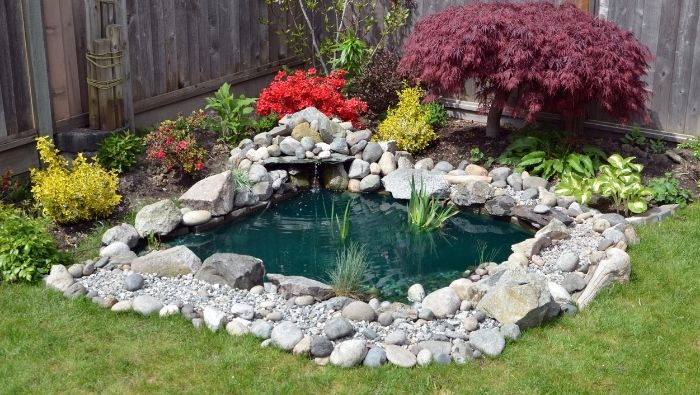Affordable DIY Backyard Pond Ideas
by Reader Contributors

Add an affordable water feature to your backyard oasis with one of these DIY backyard pond ideas. You can have your own sea of tranquility on the cheap.
Dear Dollar Stretcher,
I’d like to build a really inexpensive back yard pond. Do any of your readers have any ideas on this to share?
Brenda
Do-It-Yourself Backyard Pond Ideas on the Cheap
We reached out to our frugal readers for backyard pond ideas that were both easy to do and affordable. Here are some of the ideas they shared, from the very simple to an affordable east-to-follow step-by-step tutorial.
A Quick and Easy Pond Idea
Take a plastic kiddy pool, dig a hole the size of the pool, and place pool into hole with lip just above ground. Then use heavy black plastic and place inside of pool and drape over the edge. Bury the plastic that is over the edge with the dirt that was removed and then plant inexpensive perennials and shrubs all around the pool. Fill with water and whatever else you would enjoy like fish, plants or submersible pump for bubbles.
Lisa
A DIY Water Garden Set-Up Big Enough for Fish
Buy paddling pools, one or several. These can be dug into the ground and plants and/or fish added for lovely water gardens.
We just completed a big one. We have plants, a real boat, fish, a zillion (I counted them) tadpoles and wonderful wildlife that come to visit our pond. Ours is big – 25′ x 60′ – but oh-so-wonderful to sit and enjoy.
We bought baby koi as the big ones are just too expensive and its more fun to watch them grow along with ten-cent goldfish, too. They will get to be about 8 inches long. Be sure to add, free from your local mosquito abatement people, fish that eat the larva of those nasty little bugs.
Merry
Start living better for less.
Subscribe to get money-saving content by email that can help you stretch your dollars further.
Twice each week you'll receive articles and tips that can help you free up and keep more of your hard-earned money, even on the tightest of budgets.
Subscribers receive a free copy of our eBook Little Luxuries: 130 Ways to Live Better for Less.
We respect your privacy. Unsubscribe at any time.
An Affordable DIY Pond Made in a Day
Here’s a very simple method.
Choose a location with at least some shade to reduce algae growth. Dig a small hole in the shape you want your pond to be. It should be maybe a foot deeper than you want the finished water depth to be. Gently slope the edges. Level the top of the pond all around. Around the perimeter, dig a shelf a few inches wide and a few inches deep.
Line the whole thing with a thick layer of newspaper to keep any rocks or roots from poking through. Cover with a layer or two of heavy plastic, draping up over the perimeter shelf. Fill with a couple of inches of water and smooth out the wrinkles in the plastic. Add more water, up to the shelf. Place rocks on the shelf to anchor the plastic and provide a visual transition to the landscape surrounding the pond. Fill with a little more water, as needed. Line the bottom and sides with rocks or pebbles for a natural effect.
Our first pond took one day to build and has lasted for several years. We added two goldfish and then the wildlife moved in, frogs, birds, etc. I use the pond water to water my flowers and replace it with fresh water. Best of all, we all stop to contemplate the water for a moment or two each day, adding to our sense of peace and wealth.
Susan
An In-Depth Tutorial on DIY Backyard Ponds
My wife and I have just finished putting a pond in a “dead” corner of our lot. As to it being “cheap”, we saved about $600 off of what it would have cost us to have it professionally installed. We were just talking about it last night discussing what we would have done differently. The idea is to have a place of enjoyment, not another yard maintenance task.
Dig your hole at least 24″ deep. If you’re in the South, it will keep the water cooler for fish. If you’re in the North, it will reduce the amount of freeze damage.
Remove all grass and vegetation at least 12″ around the edge of your hole. Dig down deep enough to remove the roots completely. You don’t want to start weed whacking around the edge of your pond.
Commercial liners are 40 milliliters thick and very expensive. My plant supplier offers the liner to me at cost if I buy enough of it and purchase my plants from her. I used a 15 milliliter above ground pool liner purchased new for $40. If you can make friends with a place that sells pools, they frequently have damaged liner suitable for small ponds. Line the bottom of the hole with old blankets, burlap, newspaper anything to cushion the bottom and help protect the liner.
Pumps are tough to get a bargain on. Nobody puts them on sale during the hot months. Maybe buy it this winter if you’re not in a hurry.
The best advice I can give you is not to scrimp on this. It will reduce your enjoyment if you’re expecting a babbling brook and all you have is a measly trickle. Pumps are rated in GPH (gallons per hour). Buy one that has a GPH rating of at least the volume of your pond. To give you a visual, the average 5/8″ garden hose produces about 800 GPH. If you have a high vertical rise, (remember it will be at the bottom of your 2-ft pond) you must increase the pump capacity significantly. For waterfalls, start looking at 1200-1500 GPH.
Don’t use a sump pump. They are not meant for continuous operation and will burn out in about a week. Also consider the cost of electricity. A pond pump must run 24/7.
Rocks were my biggest expense. Go direct to a person that supplies rock to builders/landscapers. Either online or ask a landscaper where they get theirs. If you’re fortunate to live in the North Carolina/Tennessee area, most of the landscape rock in the country comes from this area. I paid $0.20/lb., but ask the supplier. I found out they also offer rock by the square foot. For the style I wanted, flat rocks were cheaper this way. Mix in small pea gravel of a similar color to fill space cheaply. (See also: Cheap and Free Sources of Landscaping Materials.)
Plants were my next biggest expense. Try to have the patience that gardening teaches. Buy rootstock by mail order if your local nursery doesn’t carry it. The sprouted plants I bought from a water garden did not bloom any quicker than the rootstock I bought from a hardware store.
Don’t start with anything fancy. These plants will spread quicker than you can imagine and are very easy to grow. You must use fertilizer tablets monthly during bloom season. Plant perennials in the area surrounding the pond. You may be tempted to save money buy putting in bedding annuals. The money will be saved over time when you don’t have to wade into the pond to get to the plants every spring. It’s easier to use plants and thin them back than to replant every year. (See also: 12 Frugal Landscape Tips for Filling Your Yard with Plants.)
For fish, don’t immediately spend money on Koi. They run about $12 each. To get your pond started, buy feeder goldfish for about $2 for 8 fish. They will get quite large and can be trained to eat out of your hand. Any “extra” fish from aquariums can be used in the pond if they are not too hybrid. The longer the fins and the brighter the color, the less hardy they will be. I put 3 giant danios that were feeling confined in my 10-gallon tank in the pond. They immediately gave birth to 24 fish. So I have extra. Catfish and plecostamos (algae eater) are safe to leave in year-round if you live in a moderate climate.
You must have a filter. I built a two-stage filter out of some cheap parts. I used a large plastic storage bin, drilled a hole in the lid and the side. Put the motor in and secure commercial filter material over the top. The most important part is the collector. I used a 5-gallon radiator drain pan filled with lava rock and layered landscape cloth inside as a filter. This has the added bonus of being able to grow aquatic plants inside the filter.
I have a 12’x4’x2’deep pond (865 gallons) and these were my costs:
- Liner: $40
- Pump: $71
- Rocks: $250
- Plants: $125
- Fish: $2
- Filter: $12
- Total: $500
Daniel
Reviewed April 2021
Subscribe to The Dollar Stretcher, our free twice-weekly newsletter aimed at helping you live better for less on the money you already have!
Subscribers get a copy of our ebook Little Luxuries: 130 Ways to Live Better...For Less for FREE!
Popular Articles
- 7 Habits of Highly Frugal People
- 5 Simple Budget Cuts That Can Save $200 a Month
- How to Track Down Unclaimed Funds Owed You
- 32 Ways to Save Money on Your Utility Bills
- Do You Need Credit Life Insurance When Buying a New Car?
- How to Maximize Profits When Selling Online
- Staying Motivated to Continue Digging Yourself Out of Debt
On After50Finances.com
- 9 Things You Need to Do Before You Retire
- You Didn’t Save Enough for Retirement and You’re 55+
- When Empty Nesters Reorganize and Declutter Their Home
- Reinventing Your Career in Your 50s or 60s
- What Mature Homeowners Should Know about Reverse Mortgages
- 2 Reasons to Collect Social Security Benefits As Soon As Possible



